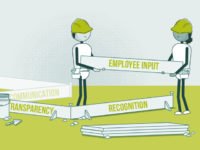The employee experience phenomenon snuck up on many.
One minute, everyone is obsessing over the business implications of employee engagement. The next, every other HR business partner you know has a title like “Chief Employee Experience Officer.” How did we get here?
Today on the Bonfyre Breakdown, we’re taking a look at a recent Chief Executive article from Lior Arussy, President of Stravity Group, who puts the work of improving the employee experience under the microscope.
What’s it about?
Arussy posits that the employee experience focus first started with something many people are still trying to figure out today: managing millennials in the workplace. That, in turn, played a part in building up a bigger discussion about how a strong company culture strategy is ultimately a strong mechanism for delivering business results. Now, people are trying to build great employee experiences to do just that.
But how would you even begin improving the employee experience? Arussy has some thoughts on the starting point, which we’ll explore below.
Get the checklist: How better communication can improve the employee experience.
Why do we love it?
By the accounts of Arussy and other thought leaders like Jacob Morgan, the employee experience is still a relatively new focus for organizations. The purpose and various dimensions of the employee experience are actively evolving for those that specialize in it.
While the language leaders use to discuss employee experience overlaps considerably with employee engagement and company culture, it is very much its own thing. Employee experience is a holistic specialization. It focuses on every touchpoint of an employee’s journey, from first contacts in the recruiting process all the way to when they retire. The idea is that every one of these moments is to be tailored with employees’ needs in mind first, and that together they’ll add up to a sum greater than their individual parts.
But what are all these things supposed to build towards? Arussy has a one-word answer: Impact.
Employees want to see the what they do every day connected to a greater outcome. That doesn’t just mean work. Improving the employee experience requires a holistic effort. Impact, in this case, should be the through line creating a sense of consistency across every interaction an employee has with the company. As you might imagine, this is easier said than done. It’s why you see so many quick fixes pop up in response to strategic goals are better addressed with long-term solutions.
Arussy says this is the pitfall of all those popular perks and programs designed to get employees to have fun at work. “Those and many other hot employee experience ideas are nothing more than tools,” he writes. “And as tools, they can each support the employee experiences but not deliver it.”
There’s nothing inherently wrong with something like a bring your dog to work program. Initiatives of that nature bring a much needed levity and fun into the workplace. Employees will no doubt have a good experience with them, but perks, parties, and programs ultimately do not drive the employee experience.
Arussy characterizes the impact-driven employee experience as an energizing construct. When it becomes clear to employees how they’re making a difference, the experience motivates them to go that extra mile. This is the distinction between entitlement and empowerment, Arussy says.
Perks-driven employee experiences cast employees as passive agents. In this framework, employees are unable to see their potential and need things to be done to and for them. The impact-driven experience, on the other hand, recognizes employees as individuals with agency and autonomy. It treats employees as mature, powerful people ready to make a difference, Arussy says.
In order to get there, the leaders of organizations have some soul searching to do. Arussy lists a handful of key questions that necessitate an honest inquiry for improving the employee experience:
- “What are the obstacles we create to prevent people from rising up to their highest performance capacity?”
- “Why aren’t [employees] choosing to be their best in the workplace?”
- “Why aren’t [employees] proud of what we do?”
With these questions, particularly the second one, Arussy once again frames employees as having some degree of ownership over their experience. They are not, however, its sole proprietors. Every employee has the power to bring their best selves to work, but leaders must see to it that they can do so without friction. They must give employees the tools, permission, and experiences that encourage and empower. As Arussy says:
“If you are seeking to create an employee experience that matters, start with impact.”
This month’s Bonfyre Breakdown discussed “Employee Experience Boiled Down To One Word,” from Chief Executive. Curious what other stories made our latest Monthly Roundup newsletter? Hungry for the latest engagement, culture, and communications insights? Don’t miss out! Sign up for the Gather Around newsletter today!



 3 min
3 min




